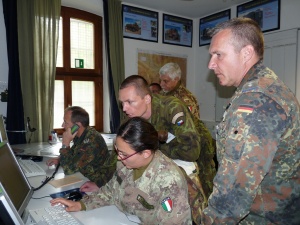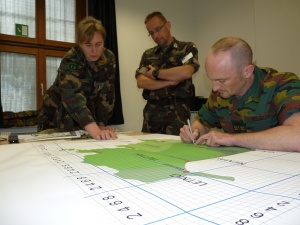
Report: OF-2 Peter JAGADICS (HUN A)
“Right Patient, Right Escort, Right Platform, Right Destination at the Right Time”
NATO Patient Evacuation Coordination Cell (PECC) Course – COE-MED-M4-008
“…I arrived in Afghanistan in March 2011 without really knowing what to expect. You can only prepare yourself to a certain level and the rest depends on the circumstances during your mission. My work as a shift officer in a multinational PECC was more than interesting, it was a major challenge. Not only was I working with German, Norwegian, Swedish and American colleagues, I was also responsible for all the patient movements in the northern region of Afghanistan during a shift period.
It has taught me to take responsibility for all of my decisions. I have learned to put things in the right perspective. I have also learned that flexibility is needed in this job, to a maximum extent.
Every day is a different day in a PECC; you need to be aware of the current situation because a medical evacuation is not something that you can plan! It happens and you react as quickly and as accurate as you can. There is little to no room for error and that is also why a very good atmosphere within your team is so important. You need to be able to count on one another.
 PECC Simulation.
PECC Simulation.
I was not that lucky to have followed the PECC course before my deployment, but I currently work as an occasional lecturer for the NATO MILMED COE. I was pleased to hear about the course because I believed there was a great necessity for something like this. We try to prepare future shift officers and dispatchers as good as possible for future missions. …” OF-1 JANSSENS Dasja (BEL Medical Service - ISAF RC North PECC March 2011 – October 2011)
It is pretty clear from my colleague’s forewords that nowadays in every NATO, EU and UN mission it becomes more and more common that multinational teams are solving different and complex tasks shoulder to shoulder to ensure the success of a mission. To guarantee high quality performance and make things run smooth during deployment, multinational troops need to be prepared for missions with high quality education and proper training.
The NATO accredited courses and trainings are designed, developed and conducted in accordance with NATO’s highest training requirements based on up-to-date operational requirements. The process is described in the BI-SC 75-7 Education and Individual Training Directive. This document provides guidance for course and training design, development, conduct, evaluation and validation processes to ensure a continuous cycle of improvement to achieve the highest level of education.
In case of the Patient Evacuation Coordination Cell Course the development process was in line with the training requirement that appeared in the NATO Education and Training (E&T) system based on a request from Allied Command Operations (ACO). The training requirement is in line with operational Lessons Learned (LL) and it taught us that PECC personnel requires an intensive standardized training in order to achieve the required situational awareness of the multinational operational environment to ensure that every casualty will be evacuated to the right destination with the right escort on the right platform at the right time. The training requirement was assessed and validated by Allied Command Transformation (ACT) Joint Force Trainer (JFT) by the so-called Training Needs Analysis (TNA) process. The ACT JFT in accordance with the Strategic Training Plan defined the need for a course and dedicated a course development task to the NATO Centre of Excellence for Military Medicine.
 PECC Team Work.
PECC Team Work.
The professional work started with a course specification phase where the requirements for the course creation were analyzed by the MILMED COE respective training personnel and appointed SMEs from the requirement authority (ACO). The course aim and development roadmap was defined with the involvement of military (medical) subject matter experts from BEL, CZE, DEU, GBR, HUN, ITA, and NLD.
The well-defined course aim provided the frame of the whole course and determined the future steps for development and provided a solid basis for the outcome of the instructional program including Learning Objectives (LO).
The aim of the PECC Course is to provide knowledge and exercise skills required to effectively work in a Patient Evacuation Coordination Cell (PECC) and to enable participants to achieve situational awareness in a multinational operational environment. But what is the PECC exactly about: the PECC provides the theatre level medical evacuation and regulating functions for all patients, moving beyond formation boundaries, in conjunction with force components and theatre logistic and movement control agencies. It is responsible for patient tracking and the maintenance of the MTF capability database.
Based on the above mentioned the Design Team determined the following LO’s:
- LO 1 understand the NATO medical support system in multinational operations
- LO 2 understand functions, responsibilities and tasks of the PECC in a NATO multinational operational environment
- LO 3 how, where and when to collect and manage required information to achieve situational awareness to support the PECC functionality
The course documentation, the so-called Course Information Form, had to be developed as well. Besides the instructional components (course curriculum) this document contains more details about the training institution, the target population (e.g.: student characteristics) and reference documents. The design team also created the content of the lectures and the syndicate works. When the course curriculum was developed the concept was tested in a PILOT Course.
During a design phase MILMED COE searched for the best location to conduct this course, because in such a practical topic like the PECC the venue is as important as a well-prepared course curriculum. Fortunately the venue was given; the Centre for Operational Training and Exercise of the Bundeswehr Medical Service offered its simulator to conduct the course there. The PECC simulator (Gaubodenkaserne, Feldkirchen) is based on German operational experiences and mission settings and contains the same communicational systems (secured/unsecured phone lines, faxes, radios, computer networks) that a real PECC has in the theater.
In the beginning, the course is conducted with the participation of a core instructor team; later on the team is expanded with subject matter experts on PECC to support the continuous evolvement of the course curriculum. In line with the latest trends in education and training, the PECC Course focusses also on practical education with the use of Simulators and Table Top Exercises. The Curriculum includes only 1.5 day lectures containing presentations and briefings regarding the principles and structures of a multinational operational HQ, PECC functions, structure and tasks and other PECC related issues. The rest of the week is spent on practical exercises, a mixture of computer assisted simulators (PECC and mIRC) and Table Top Exercises. In the practical part students are split in four groups with maximum 3 persons per group. The session starts with an introduction of the PECC simulator and the first group starts the scenario with a handover-takeover (HOTO) from the lecturers. The storyline of all the syndicate tasks are continuous; students never face the same situation during the 4 stages of simulation and it is also becomes more and more complicated at the end. The tasks require continuous situational awareness from the students. They are and at all times must remain aware of the operational environment, the theater medical capabilities, the bed status of all Medical Treatment Facilities (MTF), the available MEDEVAC Assets, on route flights etc.
 PECC Simulator.
PECC Simulator.
MILMED COE - in line with the latest NATO guidelines - operates a Quality Assurance System to evaluate the course outcome and to ensure high quality education in the courses. During the course, students continuously evaluate each lecture, lecturer, task, syndicate work and also the support and venue of the course. Based on the evaluation outcome and provided comments, the course curriculum will be tailored or modified if the curriculum control authority considers it necessary.
At the end of the course development process and after a successful PILOT course, NATO MILMED COE requests the accreditation of the course from ACT JFT. Based on the findings and recommendations during the Course Needs Analysis and Course Assessments processes – finished on 29 January 2013 – the PECC Course was accredited as “NATO Selected” and was included in the Education and Training Opportunities Catalogue (ETOC). The PECC Course – as well as all other NATO MILMED COE courses – is accredited by the Semmelweis Medical University (Budapest, Hungary) and awarded with 50 credit points in the Continuous Medical Education System.
NATO MILMED COE successfully conducted the first official PECC six months after the PILOT course. The course was attended by students from several NATO nations.
NATO MILMED COE - in cooperation with the Centre for Operational Training and Exercise of the Bundeswehr Medical Service - is organizing the PECC Course twice a year. NATO MILMED COE currently offers 6 different NATO accredited courses (www.coemed.org), organized twice a year (spring and autumn). Furthermore two regular and three distance learning courses are under development.
OF-2 Peter JAGADICS (HUN A)
Training Branch Courses SO3
NATO Centre of Excellence for Military Medicine
H-1255 Budapest P.O.Box 113
HUNGARY
Phone: +36-1-883-0131
E-mail: [email protected]
www.coemed.org
Date: 10/15/2018
Source: Medical Corps International Forum 1/ 2013











